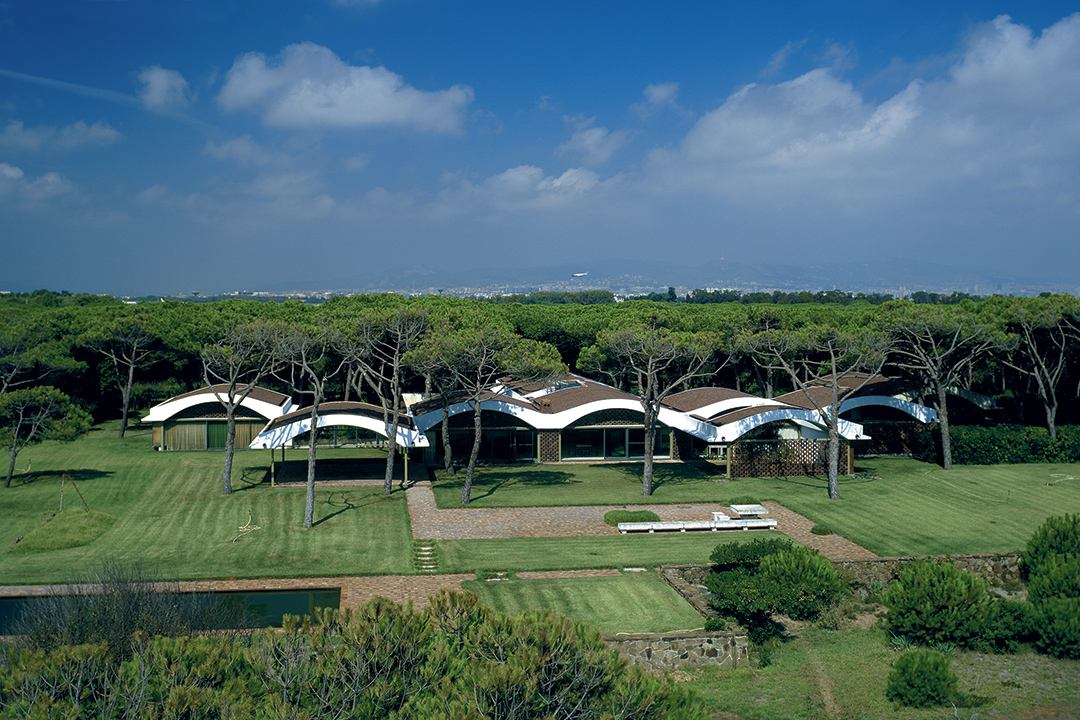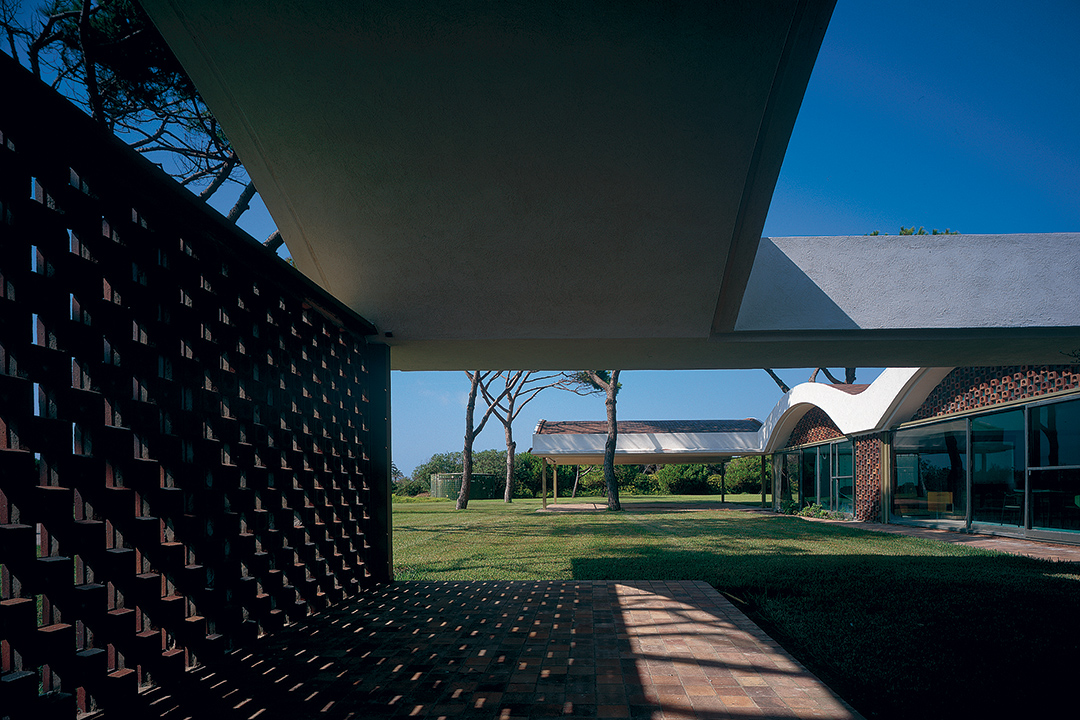Round Trip
In 1949, Antonio Bonet sets foot on his native ground after thirteen years of forced exile on account of the Spanish Civil War. During a layover in Barcelona, on his way to Bergamo for the purpose of attending the ciam 7 as the delegate of Argentina, he received a commission to design a house located in La Ricarda pond, on the coast off the Catalan capital. Ricardo Gomis and Ines Bertrand desire a spacious vacation home to share with their wide circle of friends and family.
Casa Gomis, also known as La Ricarda, will be designed and constructed through a long and elaborate process of distance collaboration and partnership between the architect and owners. The initial project came out in the mid 1950s only to obtain its definitive version and be subsequently realized in 1963.
In 1949 Bonet is 36 years old and already a young architect rich in experience. In the early 1930s he collaborates with Sert and Torres Clavé, two of the most influential representatives of the Spanish Rationalist avant-garde of the inter-war period. Before the Spanish War and fresh out of university, Bonet visits Paris requesting to join Le Corbusier’s studio. As he cannot initially work at Rue de Sevres, Bonet provides assistance as an on-site architect to Sert and Lacasa in the temporary installation of the Spanish Pavilion in Paris in 1937.
It is in Paris and in the studio of Le Corbusier that Bonet will get to know and work closely with Chilean architect and painter Matta Echaurren, with whom he will eventually complete the stunning version of Maison Jaoul for the French master, and where a deep relationship will develop with Argentinian architects Ferrari Hardoy and Kurchan – the three being co-designers of the famous bkf Chair.
In the fall of 1938, Bonet arrives in the Argentinian Rio de la Plata disembarking in the Port of Buenos Aires. The first thing he and his Argentinian friends do is found Grupo Austral after the model of gatcpac and ciam.

From this moment over the next decade Bonet will build a brilliant carrier and complete works covering furniture design, exemplified by the bkf (or Butterfly) Chair, experimental construction (series of flats at the corner of Paraguay and Suipacha in 1939), urban planning for the City of Buenos Aires (Casa Amarilla in 1943) and the extensive work on city interpretation and nature integration as part of the urbanization project of Punta Ballena in Uruguay (1945–1948). Finally, at the pinnacle of a long process of return, Bonet settles in Spain in 1963.
Pied à terre
After his participation in the Bergamo ciam and upon his return to Buenos Aires, Bonet designs the initial Casa Gomis project, where a house is constructed upon a frame of narrow columns as a compact shape. The architect’s argumentation – elevation for the purpose of seeing the landscape and detaching the floor from the oscillations of ground waters – is not convincing enough for the Gomis’. They insist on major integration of and enjoyment in the nature while living in a pied à terre.
In May 1953, Bonet travels to Barcelona to present the concept of the definitive proposal establishing therein a radical change in strategy towards nature. He showed them the project with a set of plans and a colored plaster. The first design is realized on an autonomous model of pile dwelling, in the second the house is disintegrated and scattered into a diffuse organism with a surrounding terrain. At first glance, the design could seem to emulate a metamorphosis of nature. However, the result is a discovery of a distinctive genius loci.
Construction work on the house begins in 1957 and finishes in early 1963: crucial six years of written correspondence and occasional visits. This was truly a work in progress…
The house is situated on a platform that weaves a net of 9 times 9 squares measuring 8.80 by 8.80 meters sideways, which defines the interior as well as the outside spaces of the composition. The roofed part of the house is defined by twelve spatial modules of a concrete and ceramic shell vault supported by four slender steel pillars.
Different module configurations due to adding or subdividing define different parts of the program of the house articulating freely over the said Cartesian grid. The living room-dining room-kitchen sequence defines the south-oriented program while the bedroom wing, garage and bathroom define the sea-forest growth axis. Finally, an independent pavilion holds the master bedroom. The square module governs also the order and position of different exterior spaces. These acquire relevance in relation to the main rooms, turning into intermediate spaces, half-way between the interior and the surrounding nature. Thus the living room has its own vaulted porch, the access enabled via an impluvium obtained by partial removal of the vault; the children’s bedrooms possess an adjacent patio; the dining room has a complementary space in the exterior, while the kitchen and the service zone have a connected enclosure.
A complex situation such as the connection between the autonomous pavilion and the rest of the house is solved by the glass gallery simultaneously being an obstruction to physical path but without obstructing the spatial connectivity between the back and the front of the house.
From Citröhan to Dom-ino
La Ricarda is Bonet’s first Spanish project thus representing the synthesis of a wide series of buildings where the use of vault has been prioritized. Repetitious vaulting in Casa Gomis calls back the image of vaulted corridors of the Minoan tombs or the tradition of oriental bazaar. In reality, La Ricarda is a deviation in the works of Bonet. The first examples of a vaulted house were constructed in Martínez, a neighborhood of Buenos Aires in 1941, as a system of concrete vaults lowered onto load-bearing walls. Casa Berlingieri constructed in Punta Ballena (1947) is made up of a series of parallel vaulted spaces facing the Atlantic. Earlier examples such as Casa Daneri (1943) or subsequently, Casa Cruylles on the Catalan coast (1967) are more plastic and formally riskier. In La Ricarda, the formal structure of the covering element shifts from the system of barrel vaults without walls towards a system of posts and bent plates following closely the vault profile. In the terminology of the French master, La Ricarda can be seen as a hybrid between Maison Citröhan and the Dom-ino structure, both fundamental principles used profusely by Le Corbusier.

Material conservation versus meticulous restoration
In the late 1990s we were commissioned together with Fernando Alvarez to do the preparatory work of determining the conservation status of La Ricarda through an exhaustive diagnostic. The passing of time topped with especially harsh maritime climate and virtually intact original condition, made it possible, through the study, analysis and graphical relief of all parts, to arrive at a wide knowledge of an archeologist working on the well-preserved ruins.
The first and, in terms of scope, possibly the most important task was to treat the vaults so as to guarantee the durability of the entire house. The vaults of the roof are essentially made up of two shells or sheets: an interior structural shell – a 10 cm thick vault of reinforced concrete lightened with ceramic pieces, and an external shell constructed over transversal walls used for closure and water-tightness. The two shells are separated by a ventricle which originally needed to be ventilated. Malfunctioning of this inner space due to continual degradation of different construction elements had caused multiple filtrations and material imperfections or even destructions. The objective of the first stage of restoration was to restore the functionality of the roof by improving its thermic and water proofing capacities.
The following stage of recovery of the house included restoration of all vertical enclosures of the façades. Folded and sulfurized brass profiles used in La Ricarda are a technical component rarely utilized but common in its day. Similar examples can be found in certain pre-World War ii projects by Mendesohn or other across Central Europe. In face of the harshness of marine environment, brass proved to be stable when subject to oxidation. Nevertheless, the inner steel frame used to reinforce the metal joinery had oxidized causing deformities and exfoliations that seriously deteriorated certain enclosures rendering many of them useless and out of order. The restoration work focused on recovering all reusable metal joinery, maximally faithful reproduction of deteriorated sections and improving future durability by introducing new profiles of high-resistance reinforced stainless steel.
Working on the fragile heritage that is modern architecture and undertaking contemporary restoration can be somewhat of a paradox, that is, adjusting environmental parameters such as energetic efficacy or insulation capacity can destroy and condemn the very edifice up for restoration. Our way has always been finding the equilibrium between the most faithful restoration after the original model and improving its conditions of habitability and, more than anything else, future durability and stability.
Today the restoration of La Ricarda has stopped almost completely. Myopia and lack of cultural institutions in our country do not understand that maintaining and preserving modern heritage and the legacy of the twentieth century is so important for future generations as the preservation of all that is old.
As a final conclusion, with his first project after returning to Spain, Antonio Bonet has managed to reconcile the spirit of American landscape – of great and infinite horizons – with that of the Mediterranean, offering the future inhabitants of La Ricarda an example of measuring accuracy with cultural and material refinement.